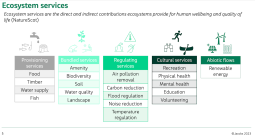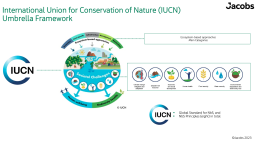Climate Change blog - Natural capital and nature based solutions
In this month’s blog, Hannah Bartram provides an overview of the recent Lunch and Learn webinar from Jacobs.
Natural capital obligations and nature based solutions are becoming a default approach across place. The session was a deep dive into the principles, tools and aids to decision-making that can support local authorities and their partners when it comes to implementation.
With over 40 attendees - a record for Lunch and Learn - it’s obviously a subject that interests many of you. It was also a hugely informative and detailed session, so I would recommend you take a look at the webinar slidedeck, which Jacobs has kindly allowed us to share. The slides contain supporting diagrams, lists of tools, guidance and references which are invaluable to those of us working in this area, and provide far more information than I can include in a blog.
We began the session with the Government’s 25 Year Environment Plan definition: ‘Natural capital is the sum of our ecosystems, species, freshwater, land, soils, minerals, our air and our seas. These are all elements of nature that either directly or indirectly bring value to people and the country.’
The natural capital approach involves examining the natural assets in an area and the ecosystem services they provide, the benefits of those services and finally, their value. Types of ecosystem services with examples are set out in Slide 1 below.
For some services, such as air purification, carbon sequestration and recreation, you can do a monetisation exercise using ENCA (Enabling a Natural Capital Approach) or the HM Treasury Green Book. It’s worth noting that the value of biodiversity is not generally monetised.
There is a large amount of guidance, tools and legislation available to you with still more due to come on stream including a salt marsh carbon code and potentially, an agriculture carbon code. Jacobs provided a list of key guidance and legislation (there is more info on the slide deck).
- Office for National Statistics overview of natural capital accounts: https://www.ons.gov.uk/economy/environmentalaccounts/bulletins/uknaturalcapitalaccounts/2022
- Natural England Environmental Benefits from Nature Tool: https://publications.naturalengland.org.uk/publication/6414097026646016
- CIRIA Benefits Estimation Tool: https://www.susdrain.org/resources/best.html
- Environment Agency Natural Capital Register & Account Tool (NCRAT): [email protected] (by email)
- UK Woodland Carbon Code: https://woodlandcarboncode.org.uk
- Liverpool John Moores University EcoservR: https://ecoservr.github.io/EcoservR/
Jacobs suggest a useful starting point for local authorities is to develop a Natural Capital Strategy that can tie into existing climate change strategies and decarbonisation plans. It can be invaluable to help you consider need, direction and focus and also things like whether you’re looking for a qualitative, quantitative or monetised approach. When you need to make a case that goes beyond the right thing to do, it’s a way of bringing nature into decision-making. There are various examples out there, but Jacobs cited Greater Manchester Combined Authority and Derbyshire County Council.
The second part of the session covered nature based solutions. While there are many similar definitions to be found, in essence, a nature based solution is one that works with nature to address societal challenges, providing benefits for both human well-being and biodiversity.
The International Union for the Conservation of Nature (IUCN) has set out in the diagram below how nature based solutions can work to address societal challenges at any context or scale, as well as provide additional benefits in human wellbeing and increased biodiversity. They also have a wealth of useful information and guidance including a series of standards and principles to support quality nature based solutions (see Slide 2 below also included in the slidedeck).
There is an almost inexhaustible list of nature based solutions, examples are included in the slide deck. Some are relatively new, such as rewilding and rain gardens, while others including flood alleviation and urban tree planting are better established.
Whether you are a developer, owner or operator, there’s legislative compliance as well as stakeholder demand, environmental governance and sustainability strategies to fulfil. From November 2023, there will be a requirement for developments to have a 10% biodiversity net gain. It actually has a very complex mechanism and the quality of habitat has a significant bearing. As a result, projects need to consider nature from the outset rather than as final mitigation. Companies like Jacobs have already started looking for a natural response to challenges to begin with rather than going down a traditional engineered route.
The Living Planet Report 2022 identified a global 69% decline in the abundance of wildlife populations from 1970 to 2018. That shouldn’t be the legacy we pass on to future generations, so if we use nature based solutions, we not only help mitigate the damage already done, we start to rebuild. Biodiversity net gain has to become our default approach, it benefits everyone.


